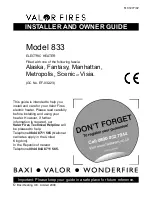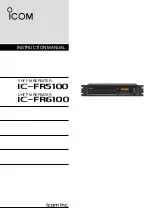
7 Configuration
Installation manual
19
EA23DA6V(7)+9W
Daikin Altherma 3 H F
4P556073-1A – 2021.09
INFORMATION
Only for systems with integrated domestic hot water tank: If
the storage temperature setpoint is higher than 50°C,
Daikin recommends NOT to disable the backup heater
second step because it will have a big impact on the
required time for the unit to heat up the domestic hot water
tank.
Capacity step 1
#
Code
Description
[9.3.4]
[6‑03]
▪ The capacity of the first step of the
backup heater at nominal voltage.
Additional capacity step 2
#
Code
Description
[9.3.5]
[6‑04]
▪ The capacity difference between the
second and first step of the backup
heater at nominal voltage. Nominal
value depends on backup heater
configuration.
7.2.5
Configuration wizard: Main zone
The most important settings for the main leaving water zone can be
set here.
Emitter type
Depending on the system water volume and the heater emitter type
of the main zone, the heat up or cooling down of the main zone can
take longer. This setting can compensate for a slow or a quick
heating/cooling system during the heat up/cool down cycle (cooling
only with EKHVCONV2 installed).
The target delta T for the main zone will depend on this setting.
Target delta T control is only possible in case only 1 zone is active.
Pump control will be different when both zones are active.
In room thermostat control, this setting will influence:
▪ the maximum modulation of the desired leaving water
temperature.
▪ the possibility for usage of the automatic cooling/heating
changeover based on the indoor ambient temperature (only with
EKHVCONV2 installed).
Therefore it is important to set this correctly and in accordance with
your system layout.
#
Code
Description
[2.7]
[2‑0C]
▪ 0:
Underfloor heating
▪ 1:
Fancoil unit
▪ 2:
Radiator
The setting of the emitter type has an influence on the space heating
setpoint range and the target delta T in heating as follows:
Description
Space heating
setpoint range
Target delta T in
heating
0:
Underfloor
heating
Maximum 55°C
Variable
1:
Fancoil unit
Maximum 55°C
Variable
2:
Radiator
Maximum 65°C
Fixed 8°C
NOTICE
Average
emitter
temperature
=
Leaving
water
temperature – (Delta T)/2
This means that for a same leaving water temperature
setpoint, the average emitter temperature of radiators is
lower than that of underfloor heating because of a bigger
delta T.
Example radiators: 40–8/2=
36°C
Example underfloor heating: 40–5/2=
37.5°C
To compensate, you can:
▪ Increase
the
weather-dependent
curve
desired
temperatures [2.5].
▪ Enable leaving water temperature modulation and
increase the maximum modulation [2.C].
Control
Define how the operation of the unit is controlled.
Control
In this control...
Leaving water
Unit operation is decided based on the leaving
water temperature regardless the actual room
temperature and/or heating or cooling demand
of the room.
External room
thermostat
Unit operation is decided by the external
thermostat or equivalent (e.g. heat pump
convector).
Room thermostat
Unit operation is decided based on the ambient
temperature of the user interface used as a
room thermostat.
#
Code
Description
[2.9]
[C‑07]
▪ 0:
Leaving water
▪ 1:
External room thermostat
▪ 2:
Room thermostat
Setpoint mode
Define the setpoint mode:
▪
Fixed
: the desired leaving water temperature does not depend on
the outdoor ambient temperature.
▪ In
WD heating, fixed cooling
mode, the desired leaving water
temperature:
▪ depends on the outdoor ambient temperature for heating
▪ does NOT depend on the outdoor ambient temperature for
cooling
▪ In
Weather
dependent
mode, the desired leaving water
temperature depends on the outdoor ambient temperature.
#
Code
Description
[2.4]
N/A
Setpoint mode
▪ 0:
Fixed
▪ 1:
WD heating, fixed cooling
(only with EKHVCONV* installed)
▪ 2:
Weather dependent
When weather dependent operation is active, low outdoor
temperatures will result in warmer water and vice versa. During
weather dependent operation, the user can shift the water
temperature up or down by a maximum of 10°C.
Schedule
Indicates if the desired leaving water temperature is according to a
schedule. Influence of the LWT setpoint mode [2.4] is as follows:
▪ In
Fixed
LWT setpoint mode, the scheduled actions consist of
desired leaving water temperatures, either preset or custom.














































